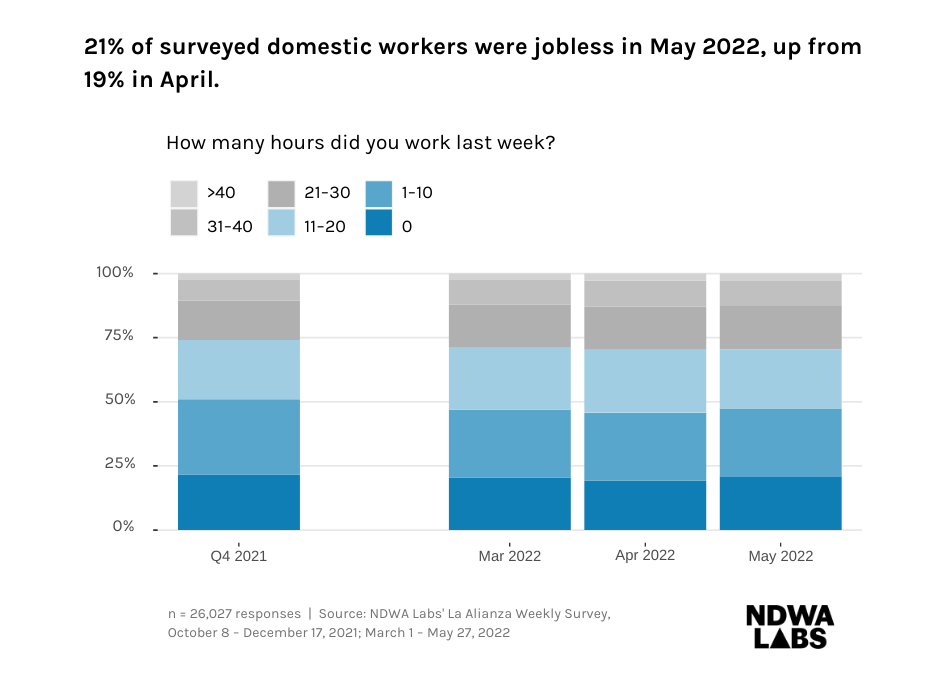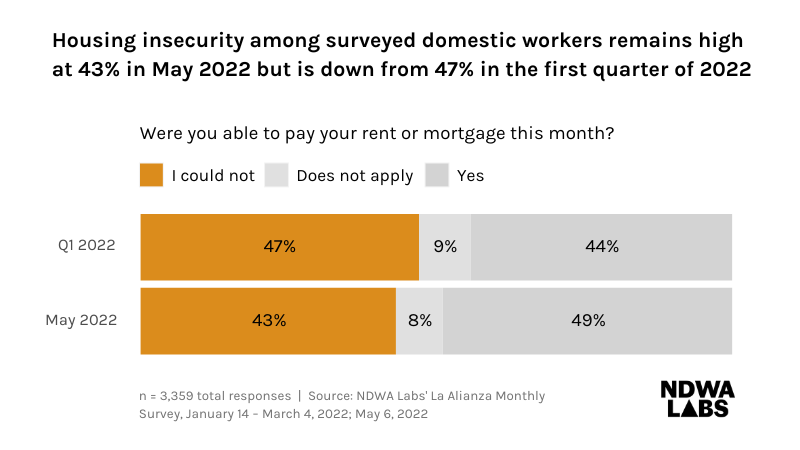JOBLESSNESS FOR DOMESTIC WORKER RESPONDENTS INCREASED TO 21% IN MAY
7 in 10 domestic worker respondents earned less than $15 per hour in May
Domestic Workers Economic Situation Report · May 2022
Source: La Alianza surveys, NDWA Labs
Released: June 7, 2022
The Bureau of Labor Statistics’ May Jobs Report shows the number of jobs added in May was above market expectations.1 Unemployment rates for Latina and Black women increased in May 2022.
Similarly, NDWA Labs’ May Report shows that the percentage of jobless domestic worker respondents increased to 21%. Joblessness for domestic worker respondents was 19% in April and 20% in March. May joblessness represents more than double the 9% who reported having no jobs before COVID-19.2
Domestic workers are the nannies, homecare workers, and house cleaners whose work is essential to our economy, and yet they are one of the most vulnerable and marginalized groups of workers. Even before COVID-19, domestic workers earned less than the average US worker and were three times as likely to be living in poverty.3
La Alianza survey data of Spanish-speaking domestic workers shows how the pandemic has amplified the vulnerability of this workforce. Domestic workers continue to face low wages and high levels of joblessness and underemployment. A contextual note regarding our findings: domestic workers, and particularly house cleaners, often have multiple employers. This means they may have to schedule several jobs in a given week in order to make ends meet.
May Jobs Report - Bureau of Labor Statistics
Each month, the US Bureau of Labor Statistics (BLS) releases an Economic Situation Summary with employment and other labor market data. This is an important report to keep track of how the economy is doing. However, domestic workers, along with other vulnerable workers, are often underrepresented in official data. Here we present an overview of the BLS Jobs report, along with NDWA Labs’ data which shows the employment and economic situation of thousands of Spanish-speaking domestic workers.
On June 3, the BLS released new employment data for May 2022.
The number of jobs added in May was above market expectations.
The unemployment rate for Latina and for Black women increased in May.
The unemployment rates for Black and Latinx adults continue to be higher compared to the rates for White adults.
The share of people who have been unemployed long-term (27 weeks or more) decreased to 23.2% of the total unemployed in May.
The economic crisis that resulted from the COVID-19 pandemic has been particularly harsh for Latina and Black women. In April 2020, the unemployment rate for Latina women reached 20%, the highest compared to other demographic groups.4 However, the recovery has been slower for Black women.
The unemployment rate for Latina women increased in May 2022 with respect to March. Similarly, NDWA Labs’ May Report shows the percentage of jobless domestic worker respondents increased slightly in May compared to April.
May Domestic Worker Jobs and Wages
May joblessness increased with respect to April 2022. An average of 21% of respondents reported having zero hours of work in a weekly survey, compared to 19% in April and an average of 22% during the first quarter of 2022.
Before COVID, 9% of respondents reported having zero hours of work.
7 in 10 respondents who had work in May were underemployed. 70% of domestic worker respondents who had at least one hour of work per week said they wanted to work more hours.
70% of domestic worker respondents earned less than $15 per hour* in May. This is the same rate as in April and represents a decrease compared to 72% of respondents who reported earning less than $15 per hour during the first quarter of 2022.
However, this is significantly higher than the share of respondents who earned less than $15 before COVID-19, which was at most 55%.**
Job Search
Around 3 in 4 domestic worker respondents, whether or not they had current work, looked for additional work in May.
76% of domestic worker respondents, whether or not they had current work, told us they had looked for new work in the past 30 days.
74% of respondents, whether or not they had current work, told us they had asked at least one of their regular employers to go back to work in the past 30 days.
Housing and Food Security
More than 4 in 10 domestic worker respondents faced housing insecurity, and 3 in 4 experienced food insecurity. This reflects the ongoing economic precarity that domestic workers experience.
In early May, 43% of domestic worker respondents, on average, said they were unable to pay their monthly rent or mortgage.
In early May 2022, 15% of respondents said they would not be able to afford food in the following two weeks and 60% were unsure if they would be able to.
In comparison, during the first quarter of 2022, 17% of respondents said they would not be able to afford food in the following two weeks and 61% were unsure if they would be able to.
About the surveys
NDWA Labs surveys Spanish-speaking domestic workers each week, via La Alianza, a Messenger chatbot. The employment numbers presented in this report include data from 4 weekly surveys in May 2022. Questions about hours worked and hourly wages are asked weekly, questions regarding underemployment and job search are asked bi-weekly, and questions around food and housing security are asked monthly at the beginning of the month.
The total number of fully completed surveys for our four May weekly surveys, which includes both new and repeated respondents, was 2,814. At the end of each survey, La Alianza provides respondents with relevant news articles and resources in Spanish. To learn more about NDWA Labs’ La Alianza survey of Spanish-speaking domestic workers, see this report.
La Alianza is a product of NDWA Labs, the innovation partner of the National Domestic Workers Alliance. NDWA Labs experiments with the ways technology can organize domestic workers and transform domestic work jobs into good jobs by bringing respect, living wages, and benefits to an undervalued and vulnerable part of the economy.
For questions, please contact us here.
Notes
1 White House Council of Economic Advisers (2022), The Employment Situation in May
2 NDWA Labs (2020), 6 Months in Crisis: The Impact of COVID-19 on Domestic Workers
3 Economic Policy Institute (2019), Domestic Workers Chartbook
4 Economic Policy Institute (2021), Jobs and Unemployment, “A more comprehensive look at unemployment rates”
*In January 2022 we modified the ranges for answer options in the hourly wage questions. The previous ranges were: $10 or less, $11-15, $16-20, $21-25, and $26 or more. As of January 2022, the ranges are: $9 or less, $10-14, $15-19, $20-24, and $25 or more.
**The share of respondents earning less than $15 in January cannot be directly compared to baseline numbers before COVID-19, due to a change in answer option ranges in 2022 (see above footnote). However, since 55% of respondents reported earning $15 or less before COVID-193, a share which is inclusive of those who earned $15 per hour, we know that the share of respondents earning less than $15 is at most 55%.




